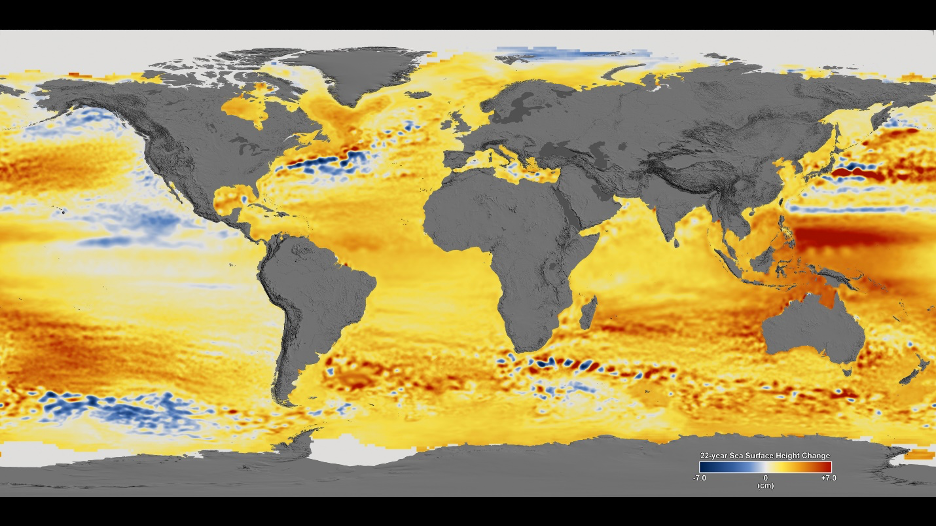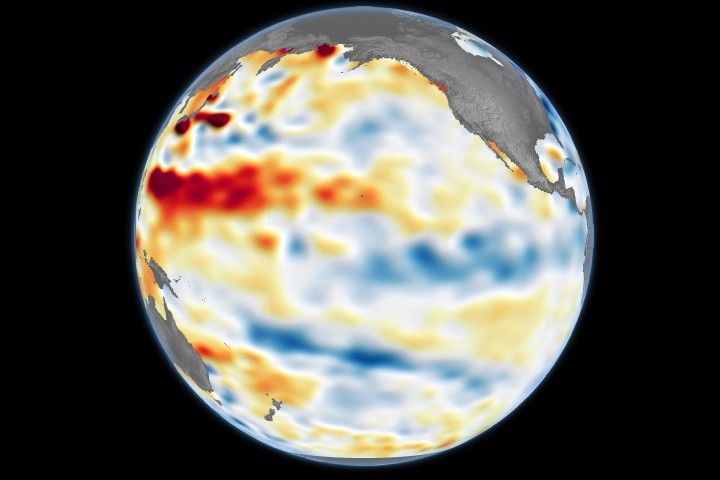
As discussed in our last Sea Level 101 blog post, we know sea level on the open ocean isn’t really flat. A number of factors combine to determine the topography of the ocean surface.
Global sea level rise is complex as well. To begin with, it has multiple causes, including the thermal expansion of the ocean as it warms, runoff of meltwater from land-based ice sheets and mountain glaciers, and changes in water that’s stored on land. These factors combine to raise the height of our global ocean about 3.3 millimeters (0.13 inches) every year. That rate is accelerating by another 1 millimeter per year (0.04 inches per year) every decade or so.
Another factor that makes sea level rise complex is that it’s not uniform around the globe. If you look at a global map of sea level rise, you’ll find it’s happening rapidly in some places and more slowly in others. This means that although sea level rise affects coastal areas all over our ocean planet, some regions feel its effects sooner and more severely than others. This is reflected in future projections of sea level rise, with many cities in Asia expected to be among the hardest hit localities. Here in the United States, cities expected to see the worst impacts include New York, Miami and New Orleans, to name but a few.
Indeed, at any given place and time around our planet, sea level rise varies. But why is that? It turns out that when it comes to sea level rise, it’s all local. And it’s all relative.
Relative Sea Level
“Relative sea level” refers to the height of the ocean relative to land along a coastline. Common causes of relative sea level change include:
- Changes due to heating of the ocean, and changes in ocean circulation
- Changes in the volume of water in the ocean due to the melting of land ice in glaciers, ice caps, and ice sheets, as well as changes in the global water cycle
- Vertical land motion (up or down movements of the land itself at a coastline, such as sinking caused by the compaction of sediments, or the rise and fall of land masses driven by the movement of continental or oceanic tectonic plates)
- Normal, short-term, frequent variations in sea level that have always existed, such as those associated with tides, storm surges, and ocean waves (swell and wind waves). These variations can be on the order of meters or more (discussed in more detail in our previous blog post).
Let’s look at these factors more closely.
When you heat up water, it expands and takes up more space. How much it expands depends on how deep the warming occurs as well as the temperature of the water to begin with. For example, in Earth’s tropics, a 1-degree Celsius (1.8 degrees Fahrenheit) warming in the temperature of the top 100 meters (328 feet) of the ocean raises sea level there by about 3 centimeters (1.2 inches). This thermal expansion of the ocean is responsible for between one-third and one-half of the overall global sea level rise observed over the last two decades. Because Earth’s ocean isn’t warming at the same rate everywhere, it results in regional differences in relative sea level rise, with areas that are warming faster seeing faster sea level rise.
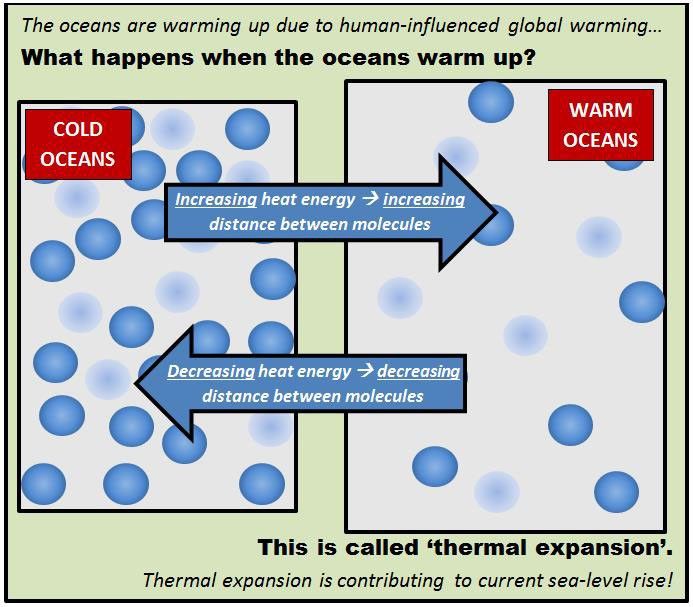

Changes in ocean circulation also contribute to regional sea level differences. For example, in the United States, El Niño, a cyclical, naturally-occurring ocean circulation pattern of warming (in the central and eastern tropical Pacific Ocean) and cooling (in the western tropical Pacific Ocean) can temporarily raise relative sea level along the West Coast by more than a foot for up to a couple of years. Similarly, along the U.S. East Coast, the speedup or slowdown of the major ocean current known as the Gulf Stream can temporarily add or subtract as much as 5 centimeters (2 inches) of sea level height to local coastlines.
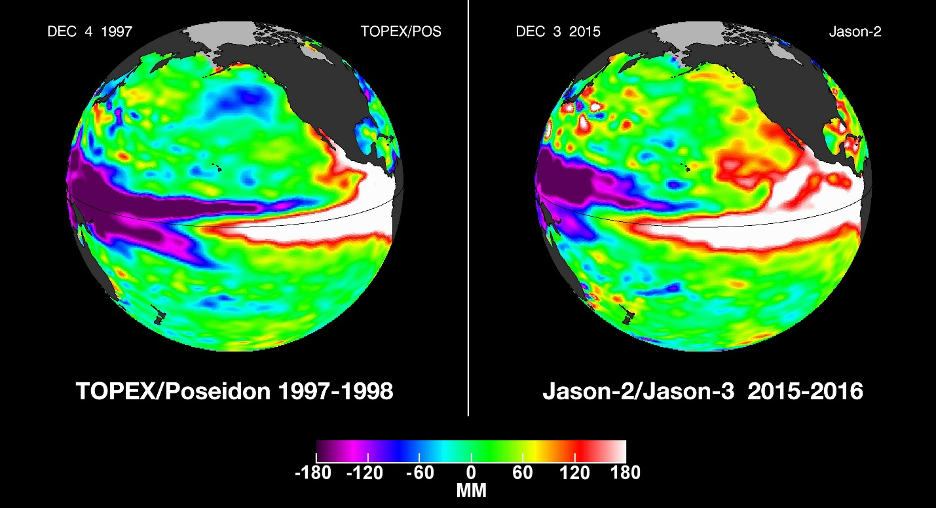
Next, there’s melting land ice in the Greenland and Antarctic ice sheets and Earth’s glaciers and ice caps. The largest contribution is from Greenland, which loses hundreds of billions of tons of ice a year and is a major contributor to sea level rise across the globe. As Greenland loses ice, the land beneath its ice sheet rises as the weight of the ice sheet is removed. As a result, Greenland itself doesn’t see any local sea level rise.
But all of its melted ice — currently averaging 281 gigatons a year, as measured by the U.S./German Gravity Recovery and Climate Experiment (GRACE) and GRACE Follow-on (GRACE-FO) satellite missions — has to go somewhere. Gravity causes it to flow into the ocean, causing sea level to rise thousands of miles away. Data from GRACE-FO tell us that melting land ice in glaciers, ice caps, and ice sheets contributed about two-thirds of global sea level rise during the last decade.
These images, created from GRACE data, show changes in Greenland ice mass since 2002. Orange and red shades indicate areas that lost ice mass, while light blue shades indicate areas that gained ice mass. White indicates areas where there was very little or no change in ice mass since 2002. In general, higher-elevation areas near the center of Greenland experienced little to no change, while lower-elevation and coastal areas experienced up to 4 meters (13.1 feet) of ice mass loss (expressed in equivalent-water-height; dark red) over a 14-year period. The largest mass decreases of up to 30 centimeters (11.8 inches) (equivalent-water-height) per year occurred along the West Greenland coast. The average flow lines (grey; created from satellite radar interferometry) of Greenland’s ice converge into the locations of prominent outlet glaciers, and coincide with areas of high mass loss.
NASA
As land ice in Greenland, Antarctica and elsewhere melts, it changes Earth’s gravity field and slightly shifts the direction of Earth’s rotation. This causes uneven changes in sea level across the globe. Each melting ice mass around the world creates its own unique pattern of sea level change in the global ocean. For example, when ice melts in Antarctica, the amount of sea level rise it generates in California and Florida is up to 52 percent greater in those locations than if the global ocean just filled up uniformly, like water in a bathtub. Scientists use gravity data from the GRACE-FO mission to calculate patterns of sea level change associated with the loss of ice from glaciers, ice caps and ice sheets, as well as from changes in land water storage.
In this animation, computed from data gathered by the twin GRACE satellites since 2002, sea level is dropping around rapidly melting Greenland (orange, yellow). But near coastlines at a sufficient distance, the added water causes sea levels to rise (blue). The computational method is described in Adhikari et al. (2016, Geoscientific Model Development). These solutions are presented in Adhikari and Ivins (2016, Science Advances).
NASA-JPL/Caltech
Then there’s vertical land motion along coastlines. When land sinks (a process known as subsidence), it causes a relative increase in sea levels. When land rises (known as uplift), it results in a relative decrease in sea levels.
A number of factors, both natural and human-produced, cause land to rise or sink, including:
- Adjustments related to the rebound of land during and following the retreat of past ice sheets in North America and Eurasia at the end of the last Ice Age (known as isostatic, or post-glacial, rebound). The retreat of the ice sheets lightened the load of mass on the underlying mantle deep below Earth’s surface, causing Earth’s surface there to slowly rise. Land areas that were once near the edge of these ancient ice sheets, such as along the U.S. eastern seaboard, are today falling, exacerbating sea level rise there.
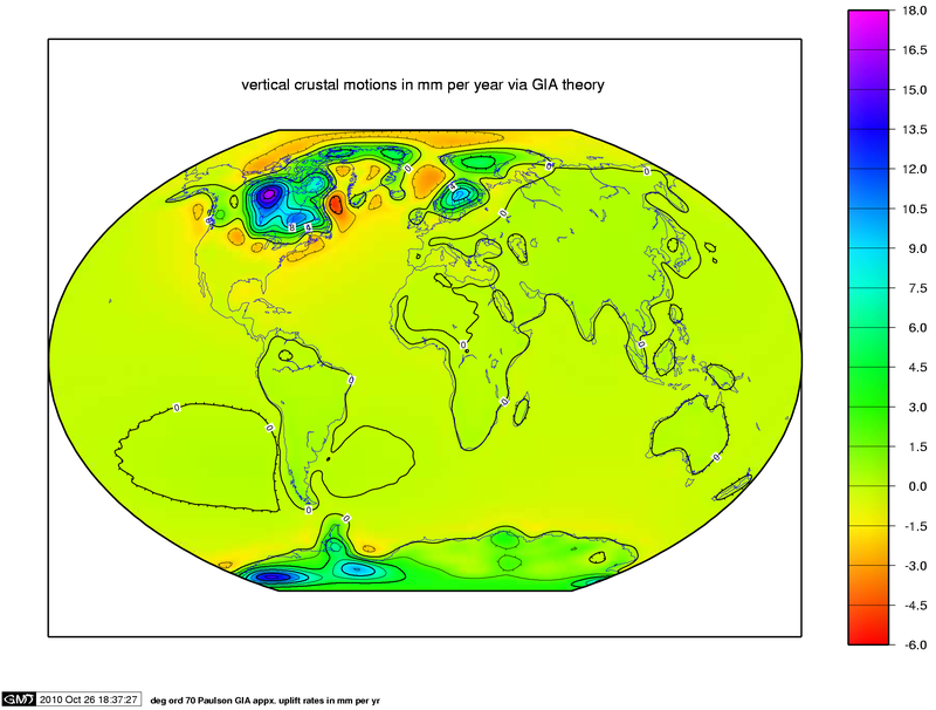
A model of present-day vertical land motion due to post-glacial rebound and the reloading of the ocean basins with seawater. Blue and purple areas indicate rising due to the removal of the ice sheets. Yellow and red areas indicate falling as mantle material moved away from these areas in order to supply the rising areas, and because of the collapse of the forebulges around the ice sheets. Credit: NASA-JPL/Caltech - Plate tectonics. Earth is divided into multiple slowly moving tectonic plates that interact with each other along plate boundaries. At some plate boundaries, the motion of one plate under, over, or past another results in vertical uplift or subsidence of the land surface above.
- Natural or human-produced compaction of sediments, such as those caused by pumping groundwater, or oil and gas. Subsidence related to groundwater withdrawal can be especially pronounced in areas with large populations and extensive agriculture. Sediments can also be compacted by construction activities by humans or by the natural settling of new soils. In the United States, subsidence is a major factor in relative sea level rise along parts of the Gulf and East Coasts.
Oceanographer and climate scientist Josh Willis of NASA’s Jet Propulsion Laboratory in Southern California says that when it comes to relative sea level rise at any particular coastal location, subsidence is the most immediate consideration.
“People in coastal areas need to know what the land is doing right now where they live,” he said. “Is it sinking? If so, how fast? When you combine a sinking coastline with sea level rise caused by other contributing factors, you’re in trouble. Remember, scientists are projecting feet of global-mean sea level rise in this century. But in some places, land can sink by one foot in a decade. We have to understand all of these pieces before we can project future sea level rise at a beach near you.”






























